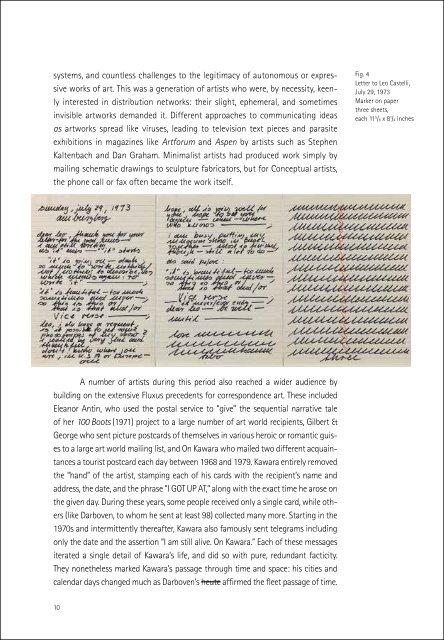Hanne Darboven
Darbovenweb
Darbovenweb
You also want an ePaper? Increase the reach of your titles
YUMPU automatically turns print PDFs into web optimized ePapers that Google loves.
systems, and countless challenges to the legitimacy of autonomous or expressive<br />
works of art. This was a generation of artists who were, by necessity, keenly<br />
interested in distribution networks: their slight, ephemeral, and sometimes<br />
invisible artworks demanded it. Different approaches to communicating ideas<br />
as artworks spread like viruses, leading to television text pieces and parasite<br />
exhibitions in magazines like Artforum and Aspen by artists such as Stephen<br />
Kaltenbach and Dan Graham. Minimalist artists had produced work simply by<br />
mailing schematic drawings to sculpture fabricators, but for Conceptual artists,<br />
the phone call or fax often became the work itself.<br />
Fig. 4<br />
Letter to Leo Castelli,<br />
July 29, 1973<br />
Marker on paper<br />
three sheets,<br />
each 11 5 /8 x 8 1 /4 inches<br />
A number of artists during this period also reached a wider audience by<br />
building on the extensive Fluxus precedents for correspondence art. These included<br />
Eleanor Antin, who used the postal service to “give” the sequential narrative tale<br />
of her 100 Boots (1971) project to a large number of art world recipients, Gilbert &<br />
George who sent picture postcards of themselves in various heroic or romantic guises<br />
to a large art world mailing list, and On Kawara who mailed two different acquaintances<br />
a tourist postcard each day between 1968 and 1979. Kawara entirely removed<br />
the “hand” of the artist, stamping each of his cards with the recipient’s name and<br />
address, the date, and the phrase “I GOT UP AT,” along with the exact time he arose on<br />
the given day. During these years, some people received only a single card, while others<br />
(like <strong>Darboven</strong>, to whom he sent at least 98) collected many more. Starting in the<br />
1970s and intermittently thereafter, Kawara also famously sent telegrams including<br />
only the date and the assertion “I am still alive. On Kawara.” Each of these messages<br />
iterated a single detail of Kawara’s life, and did so with pure, redundant facticity.<br />
They nonetheless marked Kawara’s passage through time and space: his cities and<br />
calendar days changed much as <strong>Darboven</strong>’s heute affirmed the fleet passage of time.<br />
10


